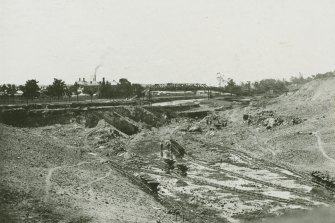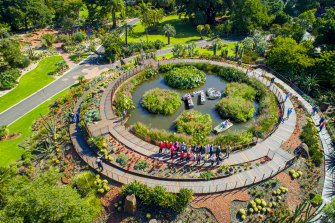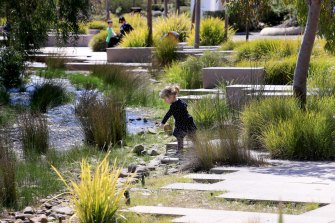

The course of the Yarra was altered at the turn of the 20th century.Credit:Royal Melbourne Botanic Gardens
From the landscape’s high points they saw ceremonial sites, on the other side of Birrarung and where Government House now stands, and far away to places known today as Arthurs Seat and the Macedon Ranges. Those views and so much else are gone, including the lagoon: separated from the river, which was straightened in the late 19th century, it became the gardens’ Ornamental Lake.
All is not lost, however. There is remnant original vegetation, including two river red gums pre-dating that stroke of Gipps’ quill, and also revegetated areas – most notably Long Island, planted with flora that formerly thrived here such as edible yam daisy and river mint. Plans are afoot to showcase this area with a major new gardens entrance, the Birrarung Gate, located where the river once flowed.

Celebrating the 175th at Guilfoyle’s Volcano in the Botanic Gardens.Credit:
The traditional owners’ knowledge also endures. Some is revealed in this year’s Garden Gathering Aboriginal cultural events, including autumn’s bushfoods walk, and Seasons, which explores the Kulin Nation’s traditional seasonal calendar. “We commissioned [this] sound piece with local Aboriginal artists and Elders” last year, says Harrington. “We were one week into the season when COVID struck.” It returned to the Blak Box portable sound pavilion on Thursday, and continues until June 5.
The gardens’ regular Aboriginal Heritage Walk also showcases First Nations knowledge. Guide Den Fisher, a Wakka Wakka man originally from Queensland, reveals plants’ traditional uses: locals such as the blanket-leaf shrub, with super-soft leaves that make handy bandages, and plants from elsewhere in Australia, such as the bunya pine. Fisher remembers eating the nuts from big bunya cones as a child.
This walk is among the activities continuing through winter. Others include forest therapy, a guided wellbeing experience based on the Japanese practice of shinrin-yoku that helps participants find calm through nature. The gardens’ National Science Week (August 14-22) program includes Future Landscapes expert talks and the launch of Flora and the Baron.
Created by Bowerbird Theatre, this creative audio experience will give visitors a virtual guided tour by Baron Ferdinand von Mueller. No doubt the gardens’ first director, appointed in 1854, will note the absence of his straight paths and scientifically ordered plantings. They were swept aside by his successor, William Guilfoyle, who created the picturesque landscape we essentially see today.
The gardens continue to evolve of course. Apart from replacing fallen trees, “each director is trying to add another way or telling stories about plants”, says Entwisle. That may include new gardens, such as the Arid Garden, which not only showcases a significant cacti and succulent collection, but has also introduced more accessible ways of presenting information. “We tried to create layers [of information] across the garden,” says Harrington, including “seat curios, kids’ panels and an audio work” – the first Sonica Botanica, available since summer’s Garden Gathering.
Climate change is a key consideration in Entwisle’s plans for the gardens. “Every time we plant something now we think about climate change predictions for Melbourne,” he says. Planted last year around a fallen 130-year-old white oak, the gardens’ three youngest oaks are species “from areas that are a little bit warmer and a little bit drier than Melbourne today”, including Mexico.
Loading
Besides the Birrarung Gate and revamped Herbarium – part of a new Nature and Science Precinct that will also include the heritage observatory – the director wants to entice visitors with more winter events too. “I don’t think people realise just how lovely it is to walk through a wintry garden,” says Entwisle, who hopes that Lightscape, an immersive, colourful, light-filled experience postponed last year, will proceed in 2022.
Meanwhile, Entwisle’s legacy as director, a position he’s held since 2013, will soon include a book celebrating the gardens’ 175th anniversary. Due later this year, it’s made up of “individual stories of people who have interacted with the gardens over the years”, from workers to visitors, he says.
“The Botanic Gardens are about stories and connections ... I came here as a child, I was lucky enough to work here as a scientist, and now I’m director. My own life story is built around this garden. I’m not unique in that regard; everyone has their own story.”
Visit rbg.vic.gov.au for event details, including winter programming to be announced in late May.

Cranbourne’s botanic gardens.Credit:Wayne Taylor
MELBOURNE’S SECRET GARDEN
The Royal Botanic Gardens Cranbourne covers 363 hectares and has won more than 30 local and international design awards, yet “even people who live in Cranbourne don’t always know it’s there”, says Tim Entwisle. Completed in 2012, the Melbourne gardens’ under-appreciated sibling is mostly made up of easily accessible remnant bushland, alongside a 15-hectare botanic garden showcasing Australia’s native flora.
In order to raise its profile, experiences including forest therapy and guided bird-watching were recently introduced, as well as a shuttle bus linking the gardens to Cranbourne train station. There’s more to come, says Entwisle, including new gateways, at this place “designed to show people what you can do with Australian plants”.
It’s also designed to impress, with “beautiful sculptural elements [and] lovely displays of plants that are as much architectural as they are botanical or horticultural”. Both the botanic garden and bushland are particularly impressive during winter and early spring, when many native plants flower.
The Melbourne and Cranbourne gardens are “complementary … but quite different”, says Entwisle. They “stand out internationally as two of the best of what they are: one of the most beautiful heritage gardens, and one of the most fascinating, stunning, modern” gardens.






 Add Category
Add Category